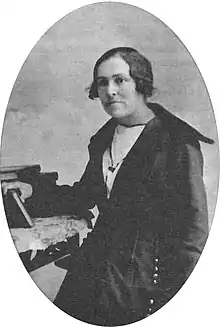María Angélica Idrobo
María Angélica Idrobo (July 29, 1890 – February 26, 1956) was an Ecuadorian writer and feminist activist.

Biography
María Angélica Idrobo was born in 1890 in Otavalo canton in the province of Imbabura, Ecuador.[1] Her surname is also sometimes spelled Hidrovo or Idrovo.[2][3]
Idrobo stood out as a student at an early age, and she received a scholarship to a normal school, which trained women to become teachers, in Quito.[4]
After graduating, she dedicated herself to teaching, becoming experienced in pedagogy and receiving further scholarships to train in Argentina and Uruguay. She settled permanently in Quito and founded several schools, including Ariel de Guayaquil, Fernández Madrid, and Simón Bolívar,[5] and she also worked as the rector of the Manuela Cañizares Normal School, shaping its curriculum for many years.[1][4] She was a firm defender of secularism in education.[4]
Beyond her teaching career, Idrobo was also a pioneering women's rights activist. Along with her colleague Zoila Ugarte, she founded the Sociedad Feminista Luz de Pichincha, a feminist organization, in 1922.[4][6] She also served as president of the organization[4] and was heavily involved in the Alianza Femenina Ecuatoriana, serving as the group's secretary of education for two years.[7] She focused on the importance of education for women and argued that women should be welcomed into the country's intellectual circles.[8]
Idrobo also distinguished herself as a writer. She contributed to various publications including La Nación,[9] and in 1934 she collaborated on the founding of Revista Alas, a feminist magazine.[10] Her most important publication is considered to be the childcare manual Homenaje a la Madre, first published in 1934.[11][12]
Idrobo remained single throughout her life.[8] She died in Quito in 1956.[4] Multiple schools have been named in her honor, and in 1960 a bust of her was installed in Quito.[13]
Selected works
- Homenaje a la Madre (1934)[14]
References
- "Idrovo María Angélica - Personajes Históricos". Enciclopedia Del Ecuador (in Spanish). 2016-04-13. Retrieved 2020-09-08.
- "Browsing TESIS - UIO by Subject "COLEGIO MARIA ANGELICA IDROBO"". repositorio.ute.edu.ec. Retrieved 2020-09-08.
- Diario La Hora. "Esperanza Estrella es María Angélica Idrovo - La Hora". La Hora Noticias de Ecuador, sus provincias y el mundo (in Spanish). Retrieved 2020-09-08.
- "María Angélica Idrobo". El Comercio. Retrieved 2020-09-08.
- "RESEÑA HISTÓRICA 2020 - Unidad Educativa Municipal Fernández Madrid". www.educacion.quito.gob.ec. Retrieved 2020-09-08.
- "Historia – Becas Zoila Ugarte 2020" (in Spanish). Retrieved 2020-09-08.
- Salazar-Cortez, Tatiana Alejandra. "Una lectura a la versátil militancia de la Alianza Femenina Ecuatoriana, 1938-1950". Trashumante. Revista Americana de Historia Social (in Spanish) (11): 164–186.
- Proaño Corrales, Andrea Elizabeth (2014). "Incorporación de la mujer a la política a través de la prensa escrita de 1905-1935" (PDF). Pontificia Universidad Católica del Ecuador.
- Goetschel, Ana María. (2006). Orígenes del feminismo en el Ecuador. Quito: FLACSO. ISBN 978-9978-67-115-3. OCLC 1007058378.
- Rosero Garcés, Rocío. (2010). Re/construyendo historias de mujeres ecuatorianas. Maldonado Posso, Viviana. Quito: FLACSO. ISBN 978-9978-92-766-3. OCLC 1007090237.
- Pazos Carrillo, Santiago Maximiliano (2019). "Patrimonio cultural culinario en Quito: pedos de nona, suspiros de monja o buñuelos en Juan Pablo Sanz y Adolfo Aquiles Gehin y su influencia en la cocina quiteña actual". Universidad Andina Simón Bolívar.
- Cevallos Cabezas, Teresa Verónica (2020). "Hospitalidad, rol de la mujer y educación formal en Quito" (PDF). Universidad Andina Simón Bolívar.
- "ESPECIAL 4-5 Educación con el corazón durante 73 años". Diario EL NORTE (in Spanish). Retrieved 2020-09-08.
- Idrobo, María Angélica (1934). Homenaje a la madre. Liceo Municipal Fernández Madrid. Quito: Talleres Tipográficos Nacionales.